Steadiness in plantar flexor muscles and its relation to postural sway in young and elderly adults
- PMID: 20544908
- PMCID: PMC4590785
- DOI: 10.1002/mus.21599
Steadiness in plantar flexor muscles and its relation to postural sway in young and elderly adults
Abstract
To investigate the functional significance of force fluctuations during voluntary contraction with a select muscle group, we examined the association between force fluctuations during voluntary contraction with plantar flexor muscles and postural sway during quiet standing in 20 young and 20 elderly adults. Young and elderly subjects maintained a quiet standing position on a force platform. They also performed a force-matching task with unilateral isometric plantar flexion. A positive correlation was found in young and elderly adults between the coefficient of variation (CV) of center of pressure during quiet standing and the CV of force during plantar flexion only at contraction intensities of < or =5% maximum voluntary contraction that corresponded to muscle activity during quiet standing. The electromyogram power in the medial gastrocnemius was greater in the elderly than in young adults by approximately 10 Hz during quiet standing and at low contraction intensities during plantar flexion. Fluctuations in motor output during low-intensity plantar flexion were associated with postural sway during quiet standing in both young and elderly adults.
Figures
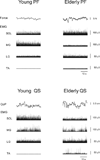

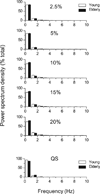
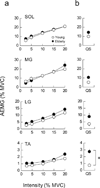

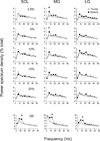
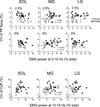
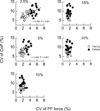
Similar articles
-
Association of force steadiness of plantar flexor muscles and postural sway during quiet standing by young adults.Percept Mot Skills. 2012 Aug;115(1):143-52. doi: 10.2466/15.26.29.PMS.115.4.143-152. Percept Mot Skills. 2012. PMID: 23033751
-
Low-frequency force steadiness practice in plantar flexor muscle reduces postural sway during quiet standing.J Physiol Anthropol. 2011;30(6):233-9. doi: 10.2114/jpa2.30.233. J Physiol Anthropol. 2011. PMID: 22197956 Clinical Trial.
-
Relationship between force fluctuation in the plantar flexor and sustainable time for single-leg standing.J Physiol Anthropol. 2010;29(3):89-93. doi: 10.2114/jpa2.29.89. J Physiol Anthropol. 2010. PMID: 20558966
-
Postural sway during quiet standing is related to physiological tremor and muscle volume in young and elderly adults.Gait Posture. 2012 Jan;35(1):11-7. doi: 10.1016/j.gaitpost.2011.03.028. Epub 2011 Aug 19. Gait Posture. 2012. PMID: 21855345
-
The variability of the force produced by the plantar flexor muscles does not associate with postural sway in older adults during upright standing.Hum Mov Sci. 2018 Aug;60:115-121. doi: 10.1016/j.humov.2018.05.009. Epub 2018 May 31. Hum Mov Sci. 2018. PMID: 29860187
Cited by
-
Losing touch: age-related changes in plantar skin sensitivity, lower limb cutaneous reflex strength, and postural stability in older adults.J Neurophysiol. 2016 Oct 1;116(4):1848-1858. doi: 10.1152/jn.00339.2016. Epub 2016 Aug 3. J Neurophysiol. 2016. PMID: 27489366 Free PMC article.
-
Coordination of plantar flexor muscles during bipedal and unipedal stances in young and elderly adults.Exp Brain Res. 2018 May;236(5):1229-1239. doi: 10.1007/s00221-018-5217-3. Epub 2018 Feb 26. Exp Brain Res. 2018. PMID: 29479634
-
Alterations in Muscle Force Control With Aging: Is There a Modulatory Effect of Lifelong Physical Activity?Front Sports Act Living. 2022 Mar 22;4:817770. doi: 10.3389/fspor.2022.817770. eCollection 2022. Front Sports Act Living. 2022. PMID: 35392594 Free PMC article.
-
Aging and skeletal muscle force control: Current perspectives and future directions.Scand J Med Sci Sports. 2022 Oct;32(10):1430-1443. doi: 10.1111/sms.14207. Epub 2022 Jul 28. Scand J Med Sci Sports. 2022. PMID: 35815914 Free PMC article. Review.
-
Modulation of force below 1 Hz: age-associated differences and the effect of magnified visual feedback.PLoS One. 2013;8(2):e55970. doi: 10.1371/journal.pone.0055970. Epub 2013 Feb 11. PLoS One. 2013. PMID: 23409099 Free PMC article.
References
-
- Galganski ME, Fuglevand AJ, Enoka RM. Reduced control of motor output in a human hand muscle of elderly subjects during submaximal contractions. J Neurophysiol. 1993;69:2108–2115. - PubMed
-
- Kornatz KW, Christou EA, Enoka RM. Practice reduces motor unit discharge variability in a hand muscle and improves manual dexterity in old adults. J Appl Physiol. 2005;98:2072–2080. - PubMed
-
- Enoka RM, Christou EA, Hunter SK, Kornatz KW, Semmler JG, Taylor AM, et al. Mechanisms that contribute to differences in motor performance between young and old adults. J Electromyogr Kinesiol. 2003;13:1–12. - PubMed
-
- Manini TM, Cook SB, Ordway NR, Ploutz-Snyder RJ, Ploutz-Snyder LL. Knee extensor isometric unsteadiness does not predict functional limitation in older adults. Am J Phys Med Rehabil. 2005;84:112–121. - PubMed
-
- Maki BE, Holliday PJ, Fernie GR. Aging and postural control: a comparison of spontaneous- and induced-sway balance tests. J Am Geriatr Soc. 1990;38:1–9. - PubMed
Publication types
MeSH terms
Grants and funding
LinkOut - more resources
Full Text Sources
Medical

